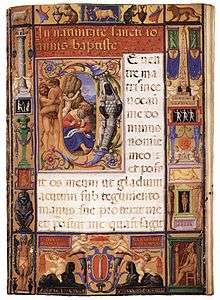Renaissance in Croatia
| Part of a series on the |
| Culture of Croatia |
|---|
 |
| People |
|
Traditions |
|
Mythology and folklore |
| Literature |
|
Music and performing arts |
| Sport |
|
Monuments |
|
Organisations |
|
The Renaissance in Croatia is a period of cultural enrichment in Croatia that began at the end of the 15th century and lasted until the second quarter of the 16th century.
Culture
Introduction
.jpg)
In the 15th century, Croatia was in a personal union with Kingdom of Hungary since 1102, Dalmatian cities where under the rule of the Venetian Republic (with the exception of Dubrovnik), later the Habsburgs gained control over the Croatian crown in the early 16th century and more and more territories came under Ottoman occupation.
Dalmatia was on the periphery of several influences, just as far from Italy as from the Ottomans in Bosnia and Austrians in the north, so it benefited from all of these. In such circumstances Dalmatian religious and public architecture flourished, with clear influences from the Italian renaissance. Three works from that period are of European importance, and would contribute to further development of the Renaissance: the Cathedral of St James in Šibenik, the Chapel of Blessed John in Trogir, and Sorkočević’s villa in Dubrovnik.
Only in this kind of environment, far from major governing centers, was it possible for the artisan known as Juraj Dalmatinac to build a church entirely to his own design – the Cathedral of St. James in Šibenik, in 1441. Besides a mixing of Gothic and Renaissance style it was also original in the combination of stone building and montage construction (big stone blocks, pilasters and ribs were bounded with joints and slots on them - without concrete) in the way that was usual in wooden constructions. This was a unique building with so-called three-leaf frontal and half-barrel vaults, the first in Europe. The cathedral and its original stone dome was finished by Nikola Firentinac following the original plans of Juraj. On the cathedral there is a coronal of 72 sculpture portraits on the outside wall of the apses. Juraj himself did 40 of them, and all are unique with original characteristics on their faces.

Work on Šibenik cathedral inspired Nicola in his work on the expansion of the Chapel of Blessed John of Trogir in 1468. Just like Šibenik cathedral, it was composed out of large stone blocks with extreme precision. In cooperation with a disciple of Juraj, Andrija Aleši, Nicola achieved a unique harmony of architecture and sculpture according to antique ideals. From inside, there is no flat wall. In the middle of the chapel, on the altar, lies the sarcophagus of blessed John of Trogir. Surrounding this are reliefs of puttos carrying torches that look like they were peeping out of doors of Underworld. Above them there are niches with sculptures of Christ and the apostles, amongst them are putties, circular windows encircled with fruit garland, and a relief of the Nativity. This is all covered with a coffered ceiling with an image of God in the middle and 96 portrait heads of angels. With so many faces of smiling children the chapel looks very cheerful and there isn’t anything similar in European art of that time.
In the entire area of the Republic of Dubrovnik there were numerous villas of nobility, unique by their functionality and space organization - a combination of renaissance villa and government building. Sorkočević’s villa in Lapad near Dubrovnik in 1521 is original in the way its parts were built in asymmetrical, dynamic balance.
Many Croatian renaissance sculptures are linked to its architecture, and the most beautiful one is perhaps the relief Flagellation of Christ by Juraj Dalmatinac on the altar of St Staš in Split cathedral. Three almost naked figures are caught in vibrant movement.
The most important Croatian renaissance painters were from Dubrovnik: Lovro Dobričević, Mihajlo Hamzić and Nikola Božidarević. They painted the altar screens with the first hints of portraits of characters, linear perspective and even still life motifs In north-western Croatia, the beginning of the wars with the Ottoman Empire caused many problems but in the long term it both reinforced the northern influence (by having the Austrians as the rulers). With permanent danger from the Ottomans in the east, the Renaissance had only a modest influence, while fortifications thrived. The plan for the fortified city of Karlovac in 1579 was first entirely new urban city to be built to a Renaissance plans (the so-called “ideal city” plan) in Europe. It was built in a radial plan, later common in Baroque. Renaissance fort of Ratkay family in Veliki Tabor from 16th century has mixed features of gothic architecture (high roofs) and renaissance (cluster and round towers) making it an example of mannerism.
Literature
Notable work:
- Judita, 1501
- Fishing and Fishermen’s Talk, 1566
- Planine ('Mountains'), 1536
- Robinja ('Slave girl'), 1530
- Vazetje Sigeta Grada, 1584
Architecture
Artists of the Croatian Renaissance
- Jeronim Vidulić - poet
- Mikša Pelegrinović - poet
- Juraj Šižgorić - poet
- Ivan Česmički - poet
- Marko Marulić - poet
- Šiško Menčetić - poet
- Ludovik Crijević Tuberon - Latinist and historian
- Džore Držić - poet
- Hanibal Lucić - poet and playwright
- Ivan Lukačić - composer and musician
- Petar Hektorović - poet and writer
- Marin Držić - playwright and prose writer
- Petar Zoranić - novelist
- Brne Karnarutić - poet
- Mavro Vetranović - writer
- Pavao Skalić - encyclopedist
- Dinko Zlatarić - poet
- Juraj Baraković - poet
- John of Kastav - fresco painter
See also
External links
| Wikimedia Commons has media related to Renaissance in Croatia. |
- Sveučilište u Zadru - Hrvatska umjetnost renesanse i baroka
- Croatian Renaissance, by Ante Kadić on JSTOR.org

